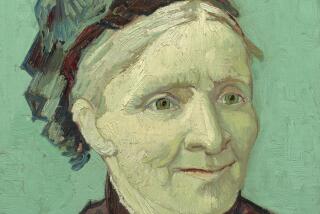Retrospective of a Virtuoso : Art review: LACMA’s R.B. Kitaj exhibition reaffirms his masterful ability, but raises questions about his intimate, confessional touch.
- Share via
The art of American expatriate painter and draftsman R.B. Kitaj is under review in a full-dress retrospective of more than 100 works at the County Museum of Art. Organized for LACMA by Stephanie Barron, the museum’s coordinator of curatorial affairs, it originated at London’s Tate Gallery and will travel to New York’s Metropolitan Museum of Art. Its catalogue is handsome.
In 1985 Kitaj, who lives in London, was elected to membership in the Royal Academy, only the third American so honored in as many centuries. (The others were Benjamin West and John Singer Sargent.) The exhibition visits Los Angeles as part of the UK/LA 1994 Festival celebration of British arts.
Such ceremonial first-cabin treatment of Kitaj’s art comes as something of a blow. Many who have admired the artist’s work for decades assumed he would always be one of those very gifted, slightly underrated figures esteemed by those with the discrimination to appreciate such unfashionable virtues as being able to draw and taking an intensely literate approach to the visual arts. Finding him in this condition is a little like discovering a secret love starring in a Las Vegas extravaganza.
Kitaj’s great virtue as an artist has been his ability to create the impression of cleaving to the Beat Generation’s archetype of the outsider. He was born in Cleveland in 1932, and as a teen-ager he shipped out as a merchant seaman. Like a character out of Conrad, he became a ferocious autodidact, devouring Lost Generation literature in his bunk and losing his virginity in a Havana brothel. You have to like a guy like that.
*
In the ‘50s his art studies were interrupted when he was drafted into the Army and did a peacetime stint stationed in Germany. Mustered out, he settled in London, the perfect move for an artist of wide interests and a dedication to obscurity. British artists from William Blake to Francis Bacon and Lucian Freud are famous for being obscure. London is a town for gregarious hermits. You can know every artist and intellectual in the city and still feel deliciously alienated.
Kitaj’s first museum exhibition was organized by Maurice Tuchman and appeared at LACMA in 1965, the heyday of the Pop era. The reigning style was visible in the poster-like punch of Kitaj’s compositions. Paintings such as “The Ohio Gang” and “Where the Railroad Leaves the Sea” seemed somehow derived from old American film noir. Images such as “The Murder of Rosa Luxemburg” confronted large social issues, but all the populist and intellectual allusions had clearly been translated to express the artist’s private preoccupations. The work was basically autobiographical. Pop strove for an almost mechanically detached irony. Kitaj’s work, by contrast, was heartfelt, intimate and a little neurotic. There was a muffled erotic charge to the pictures that felt troubled but authentically human in that era of go-go sex. The slight European mustiness and Angst of it all was oddly refreshing.
Kitaj’s art has never lost that intimate, confessional touch. Portraits of the ‘70s such as “From London (James Joll and John Golding)” are tricked out to have large symbolic meanings. Their real strength, however, comes from the vivid sense of the contact between artist and subject. A picture such as “The Hispanist (Nissa Torrents)” wafts the viewer to the flat of a member of an inbred expatriate culture floating rootless except for the anchor of its thoughts and the company of fellow castaways.
*
According to the catalogue, Kitaj is widely acquainted with the various spheres of art. He’s visited film directors such as Jean Renoir, drawn poets such as John Ashbery and Kenneth Rexroth, organized a controversial exhibition of London artists and published various essays. In 1989 he brought out the “First Diasporist Manifesto.” It was the result of a decade of rediscovering his previously ignored identity as a Jew. He began thinking about what he calls “The Jewishness of Jewish Art.” It was as if the Existential outsider finally wanted roots.
His work became more expressionistic in form, making allusions to Soutine, Chagall and the Germans. There are subjects such as “The Jewish Rider,” “The Jew Etc.” and others such as “Germania (The Tunnel)” that allude to the Holocaust.
The retrospective does nothing to diminish admiration for Kitaj’s art, but it does raise subtextual questions hovering around the issue of self-doubt. The show leaves the impression of compositions where everything is pushed to the margins, making a kind of centerless vortex of hesitation. Kitaj may explain too much, try too hard. His art seems to mistrust its own ability to tell us that it is about him.
*
He reminds us by painting his wedding, or some jokey pictures about his ailments. He wrote his own commentaries on the catalogue plates. It begins to grow narcissistic, like the novels of his friend Philip Roth. Both do their thing beautifully, but both can bumble into appearing more interested in talking about themselves than making art.
Given Kitaj’s amazing virtuosity, this subtext is like a bird being in a quandary about flying. A straight-ahead portrait drawing such as the smoldering, sooty “Dominie (Dartmouth)” tells us everything we need to know about both artist and subject.
Kitaj seems to be getting a similar idea. Two recent paintings, “The Flat” and “London Landscape,” compress his thoughts into quiet, condensed images that resonate all the more because they speak only the silent language of vision.
* Los Angeles County Museum of Art, 5905 Wilshire Blvd. , to Jan. 8, closed Mondays. Information: (213) 857-6000)
More to Read
The biggest entertainment stories
Get our big stories about Hollywood, film, television, music, arts, culture and more right in your inbox as soon as they publish.
You may occasionally receive promotional content from the Los Angeles Times.










